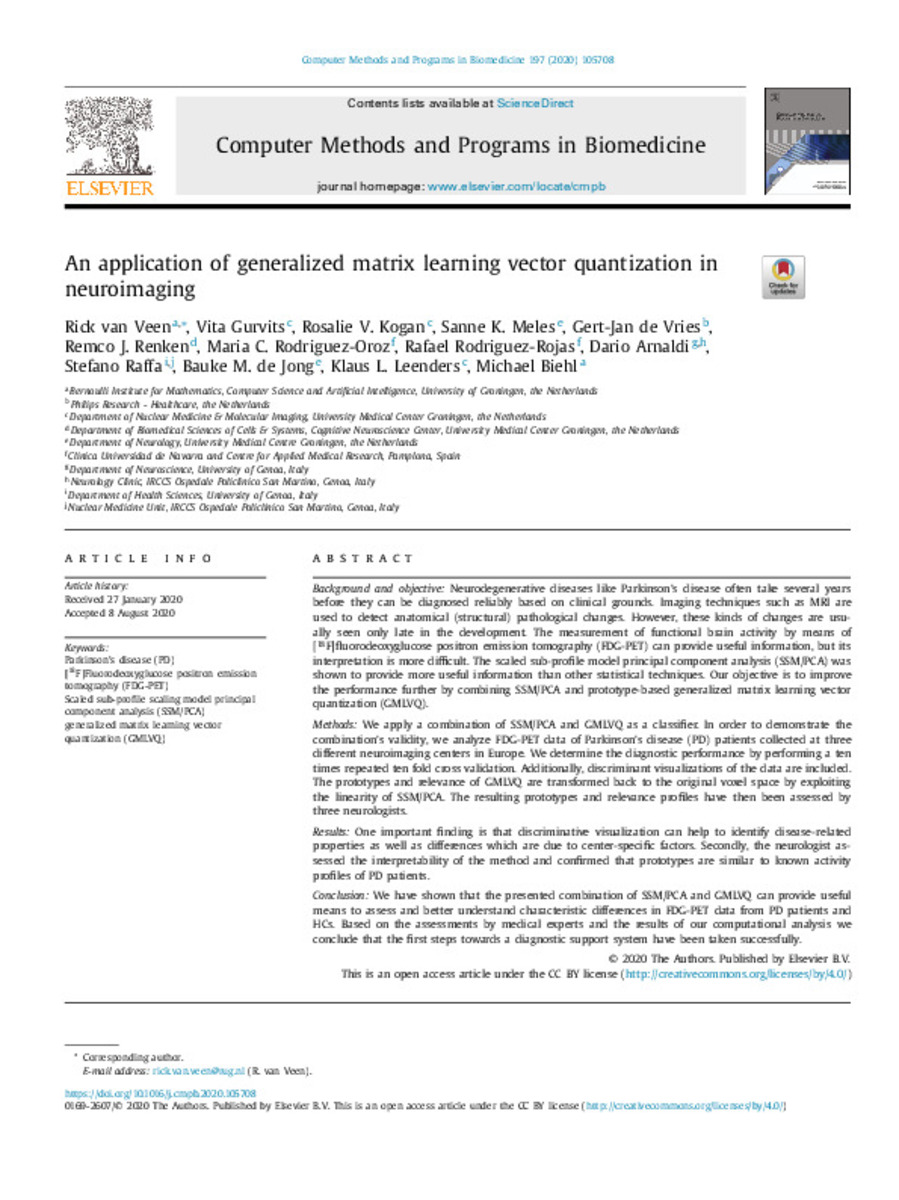Full metadata record
| DC Field | Value | Language |
|---|---|---|
| dc.creator | van-Veen, R. (Rick) | - |
| dc.creator | Gurvits, V. (Vita) | - |
| dc.creator | Kogan, R.V. (Rosalie V.) | - |
| dc.creator | Meles, S.K. (Sanne K.) | - |
| dc.creator | de-Vries, G. (Gert-Jan) | - |
| dc.creator | Renken, R.J. (Remco J.) | - |
| dc.creator | Rodriguez-Oroz, M.C. (María Cruz) | - |
| dc.creator | Rodriguez-Rojas, R. (Rafael) | - |
| dc.creator | Arnaldi, D. (Dario) | - |
| dc.creator | Raffa, S. (Stefano) | - |
| dc.creator | Jong, B.M. (Bauke M.) de | - |
| dc.creator | Leenders, K.L. (Klaus L.) | - |
| dc.creator | Biehl, M. (Michael) | - |
| dc.date.accessioned | 2023-02-06T11:22:49Z | - |
| dc.date.available | 2023-02-06T11:22:49Z | - |
| dc.date.issued | 2020 | - |
| dc.identifier.citation | van-Veen, R. (Rick); Gurvits, V. (Vita); Kogan, R.V. (Rosalie V.); et al. "An application of generalized matrix learning vector quantization in neuroimaging". Computer methods and programs in biomedicine. 197, 2020, 105708 | es_ES |
| dc.identifier.issn | 1872-7565 | - |
| dc.identifier.uri | https://hdl.handle.net/10171/65274 | - |
| dc.description.abstract | Background and objective: Neurodegenerative diseases like Parkinson’s disease often take several years before they can be diagnosed reliably based on clinical grounds. Imaging techniques such as MRI are used to detect anatomical (structural) pathological changes. However, these kinds of changes are usually seen only late in the development. The measurement of functional brain activity by means of [18F]fluorodeoxyglucose positron emission tomography (FDG-PET) can provide useful information, but its interpretation is more difficult. The scaled sub-profile model principal component analysis (SSM/PCA) was shown to provide more useful information than other statistical techniques. Our objective is to improve the performance further by combining SSM/PCA and prototype-based generalized matrix learning vector quantization (GMLVQ). Methods: We apply a combination of SSM/PCA and GMLVQ as a classifier. In order to demonstrate the combination’s validity, we analyze FDG-PET data of Parkinson’s disease (PD) patients collected at three different neuroimaging centers in Europe. We determine the diagnostic performance by performing a ten times repeated ten fold cross validation. Additionally, discriminant visualizations of the data are included. The prototypes and relevance of GMLVQ are transformed back to the original voxel space by exploiting the linearity of SSM/PCA. The resulting prototypes and relevance profiles have then been assessed by three neurologists. Results: One important finding is that discriminative visualization can help to identify disease-related properties as well as differences which are due to center-specific factors. Secondly, the neurologist assessed the interpretability of the method and confirmed that prototypes are similar to known activity profiles of PD patients. Conclusion: We have shown that the presented combination of SSM/PCA and GMLVQ can provide useful means to assess and better understand characteristic differences in FDG-PET data from PD patients and HCs. Based on the assessments by medical experts and the results of our computational analysis we conclude that the first steps towards a diagnostic support system have been taken successfully. | es_ES |
| dc.description.sponsorship | This project was (partially) funded by: The Michael J. Fox Foundation with grant ID 17081, the European Unions Horizon 2020 research and innovation program under the Marie Skłodowska-Curie grant agreement No. 676157, and the Dutch ‘Stichting ParkinsonFonds’. | es_ES |
| dc.language.iso | eng | es_ES |
| dc.publisher | Elsevier | es_ES |
| dc.rights | info:eu-repo/semantics/openAccess | es_ES |
| dc.subject | Parkinson’s disease (PD) | es_ES |
| dc.subject | [18F]Fluorodeoxyglucose positron emission tomography (FDG-PET) | es_ES |
| dc.subject | Scaled sub-profile scaling model principal component analysis (SSM/PCA) | es_ES |
| dc.subject | Generalized matrix learning vector quantization (GMLVQ) | es_ES |
| dc.title | An application of generalized matrix learning vector quantization in neuroimaging | es_ES |
| dc.type | info:eu-repo/semantics/article | es_ES |
| dc.description.note | This is an open access article under the CC BY license | es_ES |
| dc.identifier.doi | 10.1016/j.cmpb.2020.105708 | - |
| dadun.citation.publicationName | Computer methods and programs in biomedicine | es_ES |
| dadun.citation.startingPage | 105708 | es_ES |
| dadun.citation.volume | 197 | es_ES |
| dc.identifier.pmid | 32977181 | - |
Files in This Item:
Statistics and impact
Items in Dadun are protected by copyright, with all rights reserved, unless otherwise indicated.






